Edgar in World War II
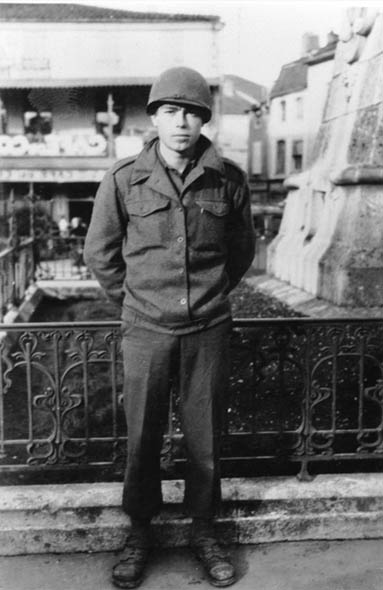
|
Edgar in uniform during World War II in St. Dizier, France. |
An Account of Edgar Nave's Experience in World War II, as told to Rodney Nave
After a trip across the North Atlantic in a banana ship converted to a troop ship, Edgar spent the better part of a year in England as the major preparation was being made for the Normandy Invasion. About three days after D-day, he went down the ropes from ship to landing craft and went ashore at Utah Beach. Spending one night enroute, they arrived at the place where they were to operate a landing strip - one which he understood to be the first operational landing field in France. He remembers gliders laying around in the fields around the landing strip and remembers it being close to St. Mere Eglise.
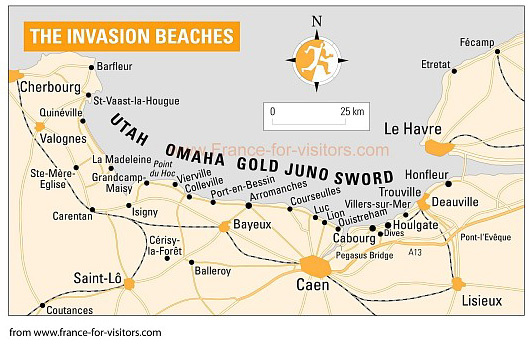
They apparently stayed there a matter of a few weeks, but then moved often to airfields constructed close behind the front lines for combat support. They roughly followed the progress of General Patton across France, touching Le Mans, Dijon, Nancy, and Metz. Edgar's primary assignment was the repair and maintenance of the P-47 fighters, but he soon took on additional duties as a courier in a jeep. Continued across France, this courier duty took him to a number of towns that he would otherwise not have seen, such as Paris, Versailles, Verdun, Lyon. He made one foray into Germany as far as Frankfurt on the Rhein and then returned to the Metz area. At the end of the European war, he came back across France to Chateaudun and then south to Marseilles to await transport. They would likely have been transferred to the Pacific if the war had not ended there too. As it turned out, they spent some time in the Marseilles area, visiting Nice and the surrounding area, and then he boarded the same ship he had come over on for the return trip to the United States.
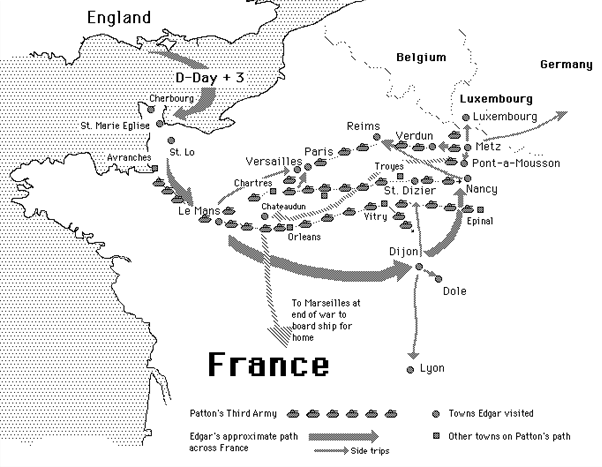
A discussion of his locations and experiences in France is on a tape and a map of the locations is on the Nave History disk.
Their troop ship docked in Glasgow on the trip over. The converted banana boat was of Argentine origin. He believes the name of it was the McAndrews. They went across in 1943, and I asked him if they weren't very nervous about German U-boat activity in the North Atlantic. "It wasn't too much fun. We detoured and zig-zagged and everything else while going over." They traveled in a big convoy and changed course often. While in England, Edgar remembers Swinden as a place where they were stationed for some time, but it was not their final staging area. He went to a school in Manchester. They also spent quite a bit of time at Bournemouth and he vaguely remembers Salisbury and Winchester. They were at Southhampton at one time. He remembers considerable time spent in London, and he dated a girl he met at Swindon who lived just outside of London in Heathergreen. He once spent three days with her family when he visited London. He thinks their location just before embarkation was in the south of England, and the 9th Air Force had three Fighter Wings in that area, the 70th, 71st, and the 84th (reference 1, p120, 124).
One of his vivid memories is the sight of hundreds of planes of all types streaming overhead in formation against a bright blue sky, with a vapor trail from each wingtip. He wished for a camera to record the sight. This was apparently before D-Day, since the weather was bad on D-Day, but his recollection puts it on or near D-Day. In the days before they left for France, they were extremely busy putting together spare engines so that engines could be replaced quickly at the forward airstrips. At times they also worked around the clock putting "desert filters" on the P-47s. He thinks this was done at Swindon. At the time, they had no idea why they were doing it, but I found mention in reference (1) that dust was an extremely serious problem in France and caused many engine failures.
We have had extensive conversations about the location of the first airstrip where Edgar worked in the days following D-Day. His recollection is that they came ashore on the beach from a landing craft about three days after D-Day. They went a short distance inland and dug in for the night and reached the airstrip on the second day on foot. "I was the first casualty in our outfit. I knocked the whole side off my thumb driving a peg for that pup tent. The first night we were there it poured rain. A bunch of them didn't build up around their tents. I woke up with several inches of water, but some of them were about to drown. They had to dig a hole."
The engineers had proceeded them and the construction was well under way if not complete when they got there. He said "A friend of mine was in the engineers. They were building on one side and fighting on the other, and we came in right behind them." The runway was apparently made out of the steel strips called "pierced steel planking" which hooked together. He remembers gliders lying in the fields around them and in fact they set up one of their workshops in one of the glider fuselages. He remembers the gliders being of wood and canvas construction. They set up camp in an apple orchard. They were there for several days before the planes came in. He did repair and maintenence work on P-47s. He remembers being close to St. Mere Eglise, and remembers making trips to Cherbourg, as described below. He apparently was there for a matter of weeks before hopping across France to several other airstrips in support of the invading forces. While there they did emergency repair on all kinds of planes, P-47s, P-51s, P-38s, B-25s. He said that the front line had moved far enough away from the airfield that they could no longer hear the guns by the time they moved to a new airfield. When they moved, they moved right up behind the front lines.
These details still leave a puzzle of locating the airstrip. There are only two glider landing sites shown on the maps we have, and they are both around les Forges, about two miles south of St. Marie Eglise.To date we have not been able to find any description or even mention of an airfield in that area south of St Mere Eglise. The map of U.S. Airfields on page 564 of (1) shows a couple of dozen airstrips on the Cherbourg peninsula. Although the scale of the map is too small to get detailed locations, there are three or four locations close to St Mere Eglise. The text (p563, ref 1) says that the 819th Engineer Battalion "landed on UTAH beach on the morning of D-Day, reconnoitered a site at Hebert under enemy fire, and after the battle had advanced beyond the site, completed a sod emergency landing site by 2115 hours." Then on page 565 it says "On 8 June the 819th began work on an advanced landing ground at Beuzeville(A-6) on UTAH beach.." There is a picture of an emergency airstrip at page 585 of (1), along with a picture of the pierced steel planking which he said was used to construct the airstrip at his location. That may well be a picture of the strip at Hebert. Edgar's first location may well have been one of these locations, Hebert or Beuzeville. Both of them are some distance from the main glider landings at les Forges, but the glider landings were fairly scattered, and both of those sites are within a couple of miles of les Forges. On page 184 of reference 3 there is a picture of gliders on the ground near les Forges in the main glider landing area, and they are on unobstructed fields. Edgar remembers that there were poles sticking up in the fields where they were; undoubtedly they were part of Rommel's glider traps as illustrated on page 101 of reference 3. Of the two locations I have documented, the most likely seems to be Beuzeville.
Locations on the Cherbourg peninsula near where Edgar worked on the first of many airstrips, servicing P-47 fighter aircraft.
Edgar recalled having been told that the airstrip which they manned was the first one in France, so we pursued it from that angle. The text of (1) describes the first airfield on the continent as being at Cordonville (19 June), manned by the 395th squadron of the the 368th Fighter Bomber Group. It says that this was the first combat squadron permanently based on the continent. The 368th was in the 71st fighter wing according to the chart on page 111 of reference (1). It describes the first headquarters of IX TAC airforce as being set up on June 10 at Au Gay (Au Guay) . We have not been able to locate those places on a map, but it appears from the discussion that they were close inland from Omaha Beach and not up near Utah Beach. Early on, Edgar said that he had thought it was Omaha Beach that he came in on, and that may be a possibility. Page 549 of (1) says that most of the 9th Air Force came ashore at Omaha. It also mentions 3 airdrome squadrons (1, Pg 549) which came ashore at Omaha during the first week of the assault to prepare fuel dumps and ammo dumps for the airstrips. The problems we see with an Omaha landing for Edgar are 1) he says it was a fairly nice beach, like Utah, while Omaha was pebbly narrow strips and steep inclines, 2) he saw a number of the German mini-tanks which we have seen mentioned only in connection with Utah Beach, 3) the gliders were in the fields all around the landing strip, and as far as we know, the only glider landings were behind Utah Beach, south of St Mere Eglise.
Looking in more detail at the text of (1), it appears that Cordonville may have been a different class of airfield and that several of the fighter airstrips may have been in operation before Cordonville. On page 563 of (1), it describes the earliest field near OMAHA beach. The chosen sites were in enemy hands, so they chose a new site. "A new site was chosen at St. Laurent-sur-Mer and by 2100 hours of 8 June the engineers had built a 3,500-foot earth runway capable of accomodating transport planes. Although St. Laurent-sur-Mer was not a previously planned field, it became the first operational American field in France and developed into one of the more important transport fields in Normandy diring the early months of the invasion. " On p 565 it is stated that a field was laid out at St. Pierre du Mont (A-1) on the 9th of June. It states that as of 11 June there were three operational air strips in the American sector. These must be Beuzeville, St. Laurent-sur-Mer, and St. Pierre du Mont. Since they were put into operation not more than a day apart, each could have easily had the impression that it was the first in operation, and indeed it may be ambiguous which one was first. If Beuzeville was in fact the strip where Edgar served, it was indeed one of the first two in France.
During his stay at the first airfield, he made several trips to Cherbourg. The first time he drove a jeep into the outskirts of Cherbourg, he understood that it was completely in American hands but he found out that wasn't completely true. "That's where I found out what them bullets sound like when they are close!" He found that close bullets made sharp cracks which hurt your ears rather than the singing sound you hear in the movies. He says he doesn't remember turning the jeep around, but that he got out in a big hurry. On one of his later trips as he was walking down one of the narrow cobblestone streets and rounded a corner, he came upon a woman squatted on the sidewalk "letting it fly". She was not in the least embarrassed; she spoke to him in a friendly manner and went on about her business. This was his introduction the the completely casual manner in which the French viewed the natural functions of relieving themselves. It was not extraordinary to see men and women squatted in public areas.Those facilities which existed in towns consisted of two spots for the feet and an open hole. There was a small door, open on top and bottom, and he observed people leaning on the doors having a conversation with the person inside. He observed couples which would continue to hold hands while the man turned to the side to relieve himself at the side of the road.
During his training, they were shown the sihlouettes of all the types of planes which were operating in the war zone and learned to quickly identify them. Then they were shown quick glimpses of formations to practice counting the number of planes. Besides the friendly planes, Ed could quickly identify the ME109 and FW190 German fighthers and others. They were issued Thompson submachine guns or the light carbines for personal weapons.
At one of the airstrips, a German plane would come over and bomb about the same time every night. They got to calling him "bed check Charlie" and joked that you could set your watch by him. They would use search lights to try to illuminate the plane to shoot at him with their anti-aircraft guns. Sometimes they would turn on the lights too soon, and would provide the plane with a better target for his bombs. One night Edgar was outside when the German plane came over and the spotlights came on to illuminate him at just the right time. He quickly identified the type of plane and then watched in the light as a bomb was released from the wing. He vividly remembers the sight of the bomb being released from the left wing of the airplane, the one on his side. It appeared at first to be traveling with the plane and then dropped faster and faster, coming right toward him. When he realized it was coming toward him, he ran behind a stack of engine crates and heard the bomb explode some distance behind him. When he examined the stack of crates, they were all empty and made of thin wood, so they wouldn't have protected him at all.
He became familiar with the sound of the multiple 50 calibre machine guns firing from the German planes. He also reported hearing the buzz bombs on occasion.
Another memorable occasion at the first airfield was the arrival of an A-20 attack bomber. They had signal pistols he called "berry pistols" which were to fire red or green balls on landing approach to indicate their condition. They were in the plane doing repairs when apparently the copilot tripped and set off one of the pistols in the cockpit while they were working on it and they had to quickly evacuate. "You can't dodge those little red and green balls. You just hope they don't hit you." It burned the whole inside of the plane and he says the burned out hulk was still sitting on the runway when they left.
Even with the action, there were French kids playing around the area. He said they found a German case with flare pistols in it near the beach where a bunch of kids were playing. When they shot one of the flares, all the kids disappeared. He was amazed at how fast they all found a hole.
He remembers traveling through St Lo and finding it nearly flattened by bombs. The thing that made that image so vivid was that they met a truck carrying a full load of 100 lb bombs barreling around a corner. They could see the tires almost flattened out sideways in the turn and were sure they were goners. I'm sure that being surrounded by the evidence of what those bombs could do heightened the awareness of danger.
Stays at many of the airstrips were very short, and there was considerable shuttling around between strips, but he remembers staying for longer times at Le Mans , Nancy, and Metz. "We followed Patton all the way up. We were right behind him all the way." He also spent quite a bit of time at Dijon, but doesn't remember doing any aircraft work there. They made use of some captured airstrips. Sometimes they moved too close to the front for comfort. "We had to move out of one. They sent us up to get a B-17 or one of those bombers. We had to repair it and get it out of there. They came back on us and were blowing up the runway right behind the tail of that aircraft as we took off. I thought sure they were going to get us."
At one airstrip he recalls a P-47 coming in and blowing up, and he saw the pilot and his seat fly out of the plane. His engine blew up. Edgar said that they had had them blow up before and they would have to pick up the pilot who would be torn all to pieces. This time they watched the seat hit the metal runway and lean back like a recliner, sliding down the runway with a shower of sparks. It stopped and finally fell over, so they went after him. "Before we got there we saw him moving so we figured he was alive. We speeded up a little bit and saw him unbuckle his belt. Then he climbed out of his seat, took his shoes off and threw them over his shoulder and met us on his way back. There wasn't a scratch on him. He couldn't figure out what was happening- sort of addled or something - and wanted to know what all the commotion was about."
Planes came in all shot up and in all kinds of conditions. The P-47s had 50 calibre machine guns in the wings. He saw planes hit the ground so hard that it pulled the slugs out of the 50 calibre shells and there would be powder all inside the wings.
By the time he got to Le Mans, he was driving a jeep for courier service on a regular basis in addition to his aircraft maintenance work. He drove to Paris and Versailles. He went to Paris several times and was amazed at the speed of the Paris Underground. He drove a jeep out of Versailles in the snow once, and it spun around and around on a hill and he thought he would lose it. It finally turned around and backed easily up to the curb and stopped. When he got through shaking, he drove on down the hill and then at a place where the road was lined on both sides with trees it started spinning around and around in the middle of the road again as he was meeting two big trucks coming up the hill side by side. Just before meeting them, it straightened out and slipped between them, only to start spinning around again on the other side of them. I have heard him mention that incident several times over the years, and I can see why it would be memorable. On some of the courier runs he would drive up to the front. There were roadblocks to stop people from just driving up the the front of the action, but when he would show them the sealed papers he was carrying, they would just wave him past the checkpoints without even examining his papers. On one courier run he met General Patton's driver and talked with him for a while.
They did some work on C-47s, twin engined cargo planes which they called "unhappy whales" because of the shape of their fuselages. Sometimes they would fly between locations in C-47s, and they did some cargo runs later on in the campaign. On one such occasion they encountered some unexpected flak which was coming through the bottom and sides of the plane. "You would see holes come in the side of the plane and you didn't know where it went. Then you'd look down and see blood and know you were part of it, and you were scared to look any more." He was leaning against the wall of the plane and saw blood coming from his hand. He said he was afraid to look anywhere else, but it turned out that he wasn't hit anywhere except on the hand. "We were flying supplies and were supposed to be pretty safe, but somebody decided to take a pot shot at us." The flights were day flights, indicating their almost complete control of the air over France.
He found Dijon to be a very strange place, a center for the detainment of displaced persons. Most of them were Germans, but there were a number of other nationalities present. There was very little food for the detainees, and the soldiers sometimes slipped them food, though it was against regulations. He said that they would not only fight over food, they would even fight over a tin can which they could use to dip in the garbage to get bits of food. One seemingly very intelligent person there offered him a wad of money for just a cup of coffee. Edgar handed it to him, cup and all, and wouldn't take the money. He became friends with that fellow and developed the skill for walking by and pouring his coffee in the fellow's cup without even slowing down. He let three women take a bath in his room since they hadn't been able to take a bath in some time. He had to pull his 45 on a French gaurd who was going up the stairs to check on them.
Edgar spent a considerable time near Metz. He has pictures of German planes shot down there. There were heavy concrete fortifications up on the hills. He said the concrete was several feet thick and he saw places where bombs had hit them and "shattered them a little on the side, but didn't get into them at all". We were discussing the bombardments, and he commented "they really plastered them. Up on the hills at Metz, where they had the underground fortifications it looked like there had been a woods at one time, a pretty thick woods. There wasn't a tree standing higher than your head. They shattered them down until there wasn't anything but stubs sticking out of the ground." There were extensive underground concrete rooms in fortifications, and he remembers seeing stacks of rifles there. He saw a small, shiny jewelers lathe in what must have been a German machine shop, and went to find tools to take it up from its bench, but returned to find that someone had beaten him to it. There he recounted the story of a buddy who had wanted a German souvenier. "The ol' boy went up there with me looking for a helmet for a souvenier and he picked up one that still had some of that fellow's head in it. That about got him, and he picked up what looked like a brand new boot laying up there and there was a foot still in it." He abandoned his search for souveniers of that type. Edgar said that there was that sort of stuff laying all over the hill.
He told the story of walking down a street in Metz, which had been in American hands for some time, and having a sniper's bullet hit the building just above his head. The shot came from a second story window, and return fire came from everywhere, almost blowing the side of the building off. Edgar was surprised at the return fire since he thought he was alone on the street.
From the Metz area he made some courier trips up into Belgium. He recalled that in the "Battle of the Bulge" area there were a lot of pillboxes they had to drive the Germans out of. They found that one of the best ways to do it was to fire one of the "berry pistols" into one of the ports. These were signal flare pistols which fired a flaming red or green ball. These balls would bounce around inside the pill box and the Germans would come running out. He remembers crossing the Siegfried Line of fortifications.
Between Metz and Nancy was a small town called Pont-a-Masson which you entered across a bridge (pont). One place in Nancy was famous for a one-block-long street which had about ten small bars with cat-houses on the top floors. The street name was appropriately Rue le Dame.
Edgar's jeep was fixed up with an aluminum housing and a manifold heater, and he says it could outrun any jeep in the outfit. It was quite popular with officers who wanted transportation. They wouldn't let the jeep go unless he went with it so he got to take a good many trips. He got to make a trip to Lyon with some officers who were going there for an investigation of some sort of accident. They were supposed to be gone overnight but didn't make it back for over a week. He was impressed with the beauty of the city, which was not much damaged except that all its bridges were blown out. On one occasion a Lieutenant insisted upon a ride somewhere, even though he was not authorized to demand such transportation. On the way he said to Edgar "I thought you said this thing would run!" At that, Edgar took off over the rough road and when he looked back sometime later, the Lt was nowhere to be seen. He never knew what happened to him. He was nervous about being court-martialled about it, but never heard from it again.
He and two other guys were once lost on a courier run and went into one small town in France that he has never been able to identify, even though he remembers it vividly. When they forded a little creek and drove into the town, the people of the town came out and the mayor met them and threw a big party. The party lasted almost all night, with more food than they could eat, and then the people headed them out in the right direction. Edgar and friends were the first soldiers of any kind that they had seen. He tried to go back there several times but never could find it.
At the end of the war in Europe, Edgar returned to the Chateaudun area and then was taken to Marseilles to await a ship. Spending some time in that area, he was able to explore Nice. They boarded the same ship he had come over on. He remembered the sight of the Rock of Gibralter as they came through the Strait. It had a cloud hanging on it, just like the picture he had seen on a postcard. He remembered that the ship had a crack down the side big enough to stick your finger in, and it would open up more when they hit waves.
P.S. June 4, 2009. Though it is 65 years past Edgar's service in World War II, sometimes he will come up with tales that I haven't heard before. At 86, he is still strong - the doctors telling him he is in fantastic shape for his age.
Today he told me of his experiences flying around the European battle front with a pilot that he described by "he was good, but he was crazy!". This story was evoked when I told him about flying around Newport with Brent. He described the plane as small, perhaps a reconnaissance plane, and thought it was called an L5. Once they were attacked by German aircraft, and the pilot dodged the fire and then fired back at the Germans. | 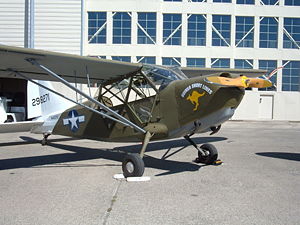 The L5 Sentinal by Stinson |
The USAAF, US Marines, and US Navy used this aircraft in the European, Pacific, and Far East theaters during World War II, and in Korea during the Korean War. The British RAF operated 100 Sentinels in India and Burma.
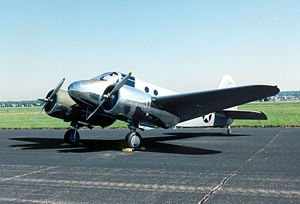 The AT10 by Beechcraft He also recalled a lot of aircraft called AT10. He saw one of them land with landing gear partially up, bending the props and getting the engine out of alignment. He apparently did a lot of work on that plane. He did general mechanical work on the planes and mentioned a lot of service on their radios. Apparently they had crystals to change the frequency of transmission to keep the enemy guessing, so his crew changed them out in the aircraft numerous times. The AT10 was built as a trainer for the US Army Air Force in which Edgar served in Europe. | |
References
1. Craven, Wesley Frank and Cate, James Lea, The Army Air Forces in World War II, Volume Three, Europe: Argument to V-E Day, January 1944 to May 1945, Chicago: University of Chicago Press, 1951. GSU Library D790 A47
2. Utah Beach to Cherbourg, American Forces in Action Series, Washington D.C.: Department of the Army, Historical Division, 1947 (Facsimile reprint 1984). GSU Library D756.5 .N6 R86
3. Botting, Douglas, The Second Front, World War II, Time-Life Books, 1978.
1944